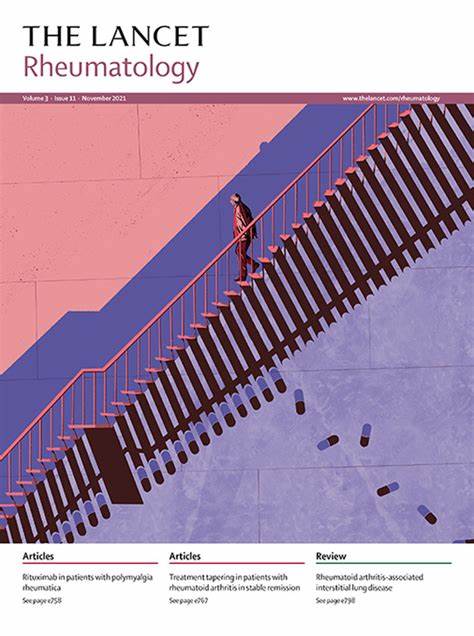Immunosuppressive agents or intravenous immunoglobulin in addition to glucocorticoids in the treatment of Susac syndrome: a French national cohort study
IF 15
1区 医学
Q1 RHEUMATOLOGY
引用次数: 0
Abstract
Background
Susac syndrome is a rare disease affecting mainly young women and is characterised by an occlusive microvessel disease limited to the brain, retina, and inner ear. No randomised controlled trial has been published or declared as ongoing to investigate treatments for Susac syndrome. We aimed to compare the effect of glucocorticoids given alone or in combination with immunosuppressive agents or intravenous immunoglobulin for the prevention of relapse in patients with Susac syndrome.
Methods
The Phenotypic and Etiological Characterization of Susac Syndrome—National Clinical Research Hospital Program study is a prospective national cohort study that started enrolling on Nov 29, 2011, and included all consecutive patients aged 18 years or older with Susac syndrome who were referred to the French reference centre (Department of Internal Medicine, Bichat–Claude Bernard Hospital, Paris). Susac syndrome was defined by either the triad of encephalopathy with typical brain MRI abnormalities, cochleo-vestibular damage, and multiple occlusions of retinal central artery branches, or at least two of the three criteria without any alternative diagnosis. Collected data included fundoscopy, retinal angiography, audiometry, cerebrospinal fluid, brain MRI, and treatment received at diagnosis; months 1, 3, 6, and 12 after diagnosis; and then annually for 5 years or in the case of a relapse. The primary outcome was defined as the first relapse occurring within a 36-month follow-up period from the first day of treatment, characterised by new clinical symptoms or signs, and new abnormalities observed on retinal angiography, audiometry, or brain MRI, necessitating treatment intensification. There was no involvement of people with lived experience at any stage. The study is registered at ClinicalTrials.gov, NCT01481662.
Findings
Between Nov 29, 2011, and Dec 2, 2022, 64 patients were included in the study, with a mean age at diagnosis of 35 years (SD 11); 41 (64%) were women and 23 (36%) were men. At diagnosis, 60 patients received glucocorticoids; 40 (63%) of 64 patients received glucocorticoids alone as a first-line therapy while 20 (31%) received glucocorticoids in combination with immunosuppressive agents or intravenous immunoglobulin. Overall, 46 (72%) of 64 patients had a first relapse with a median relapse-free survival time of 3·96 months (95% CI 2·24–16·07). Comparison of relapse-free survival showed no significant difference between the two treatment strategies (hazard ratio [HR] 1·11 [95% CI 0·56–2·17], p=0·76), compared with glucocorticoids alone as the reference group. In patients who first relapsed while treated with glucocorticoids alone, there was no significant difference in second relapse-free survival between those who did or did not receive immunosuppressive agents or intravenous immunoglobulin as a second-line therapy (HR 2·66 [95% CI 0·63–11·18], p=0·18).
Interpretation
The combination of glucocorticoids with immunosuppressive agents or intravenous immunoglobulin did not appear to reduce the risk of Susac syndrome relapse compared with glucocorticoids alone. Our findings did not support the systematic use of immunosuppressive agents in Susac syndrome.
Funding
French Ministry of Health.
除糖皮质激素外使用免疫抑制剂或静脉注射免疫球蛋白治疗苏萨克综合征:一项法国全国队列研究。
背景:苏萨克综合征是一种主要影响年轻女性的罕见疾病,其特征是局限于大脑、视网膜和内耳的闭塞性微血管疾病。目前尚未发表或宣布正在进行随机对照试验来研究苏萨克综合征的治疗方法。我们旨在比较糖皮质激素单独使用或与免疫抑制剂或静脉注射免疫球蛋白联合使用对预防苏萨克综合征患者复发的效果:苏萨克综合征的表型和病因特征--国家临床研究医院计划研究是一项前瞻性国家队列研究,于2011年11月29日开始招募,包括所有转诊至法国参考中心(巴黎比夏-克劳德-贝尔纳医院内科)的18岁或18岁以上连续苏萨克综合征患者。苏萨克综合征的定义是:具有典型脑磁共振成像异常的脑病、耳蜗-前庭损伤和视网膜中央动脉分支多发性闭塞的三联症,或者至少具备上述三项标准中的两项,但没有任何其他诊断。收集的数据包括眼底镜检查、视网膜血管造影、听力测定、脑脊液、脑磁共振成像以及确诊时、确诊后第 1、3、6 和 12 个月、5 年内每年一次或复发时接受的治疗。主要结果的定义是:自治疗第一天起的 36 个月随访期内首次复发,表现为新的临床症状或体征,以及视网膜血管造影、听力测定或脑核磁共振成像观察到的新异常,因而有必要加强治疗。在任何阶段都没有有生活经验的人参与。该研究已在 ClinicalTrials.gov 注册,编号为 NCT01481662:2011年11月29日至2022年12月2日期间,共有64名患者参与研究,诊断时的平均年龄为35岁(SD 11);其中女性41人(占64%),男性23人(占36%)。确诊时,60 名患者接受了糖皮质激素治疗;64 名患者中有 40 名(63%)接受了单独糖皮质激素一线治疗,20 名(31%)接受了糖皮质激素联合免疫抑制剂或静脉注射免疫球蛋白治疗。总体而言,64 名患者中有 46 人(72%)首次复发,无复发生存期中位数为 3-96 个月(95% CI 2-24-16-07)。与单纯糖皮质激素治疗组相比,两种治疗策略的无复发生存期无显著差异(危险比 [HR] 1-11 [95% CI 0-56-2-17],P=0-76)。在单用糖皮质激素治疗时首次复发的患者中,接受或不接受免疫抑制剂或静脉注射免疫球蛋白作为二线治疗的患者在第二次无复发生存率方面没有显著差异(HR 2-66 [95% CI 0-63-11-18],P=0-18):与单独使用糖皮质激素相比,糖皮质激素与免疫抑制剂或静脉注射免疫球蛋白联合使用似乎并不能降低苏沙克综合征复发的风险。我们的研究结果不支持在苏沙克综合征中系统使用免疫抑制剂:资金来源:法国卫生部
本文章由计算机程序翻译,如有差异,请以英文原文为准。
求助全文
约1分钟内获得全文
求助全文
来源期刊

Lancet Rheumatology
RHEUMATOLOGY-
CiteScore
34.70
自引率
3.10%
发文量
279
期刊介绍:
The Lancet Rheumatology, an independent journal, is dedicated to publishing content relevant to rheumatology specialists worldwide. It focuses on studies that advance clinical practice, challenge existing norms, and advocate for changes in health policy. The journal covers clinical research, particularly clinical trials, expert reviews, and thought-provoking commentary on the diagnosis, classification, management, and prevention of rheumatic diseases, including arthritis, musculoskeletal disorders, connective tissue diseases, and immune system disorders. Additionally, it publishes high-quality translational studies supported by robust clinical data, prioritizing those that identify potential new therapeutic targets, advance precision medicine efforts, or directly contribute to future clinical trials.
With its strong clinical orientation, The Lancet Rheumatology serves as an independent voice for the rheumatology community, advocating strongly for the enhancement of patients' lives affected by rheumatic diseases worldwide.
 求助内容:
求助内容: 应助结果提醒方式:
应助结果提醒方式:


